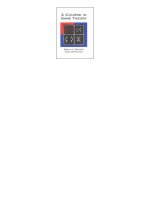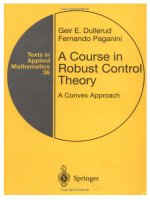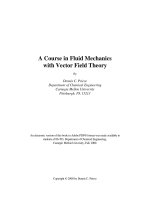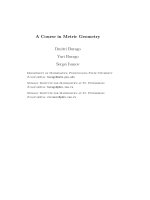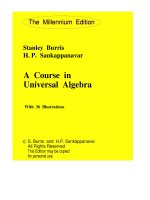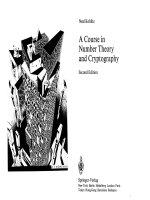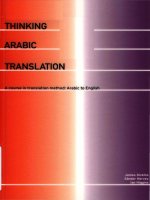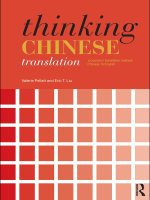Borden r a course in advanced calculus dover publications (1997)
Bạn đang xem bản rút gọn của tài liệu. Xem và tải ngay bản đầy đủ của tài liệu tại đây (19.77 MB, 430 trang )
Robert S.Borden
www.pdfgrip.com
DOVER BOOI$ ON MATHEMATICS
THeoRvor LNSAROpeRAToRs
rn Hrmmr SelcE, N. I. Akheizer & l. M.
Glazman.(6774&6)
NUN{eeR
Turonv,George E. Andrews. (68252{)
MrruEurrcru- Mooeu-rncTrcHnrques,Rutherford Aris. (68 I 3 I -9)
MooennElrurn'nRy Drrrnrrvrru Equlrrons, Richard Bellman and Kenneth
L. Cooke. (686434)
RrpneseNTAflon
Tsrony or FNns GRoups,Martin Burrow. (67487€)
A Htsronv or MrtnsrvrATrcruNormoNs, Florian Caiori. (6776U)
Ans Mlctn, on THERulss or ALcreRA,Girolamo Cardano. (6781l-3)
Euurvnnv THuonv or Atru-yrrc FuNcroNs op Ot'rg on SevsRALConapuux
VARIABLES,
Henri Cartan. (685434)
IlrnooucnoN To rHE Consrnucrrolrop CLqssFrELDs,
Harvey Cohn. (6834eX)
A Hrstonvor VEcrOnANALysrs,
Michael J. Crowe. (67910-l)
FourusRSsRnsrulo Onruoconar-FuNcrruNs,Harry F. Davis. (6597&9)
AssrRAcrALcEBRA,
W. E. Deskins. (6888&7)
AovN{ceoCmculus or SsvERlr-VARrABr.,Es,
C. H. Edwards, Jr. (68336-2)
FuncrroruruANALysrs,
R. E. Edwards. (68143-2)
Pmrru DrpERrvrru Eeumons ron ScrervrrsrsAND ErucNrERs,Stanley J.
Farlow. (67620-D
Ixrnooucrtoxro PRogABILrry,
John E. Freund. (67549-l)
VrRrrrrorurL
MerHoosFoRETcENVALUu
Pnoslsl,rs,S. H. Gould. (687124)
Pnnrru DrrpeRENrrAL
Eeumorvs op MnrHsuATrcALPuvsrcs mo [vrEcRH
Eeulnotts, Ronald B. Guenther and John W. Lee. (68889-5)
Foumn Senns,G. H. Hardy and W. W. Rogosinski.(406814)
A CoMenrAtoRrAL
INTRoDUcrroN
ro Topolocv, Michael Henle. (6796e7)
CHrRlcrsnTHsonvoF FNITEGRours,I. Martin Isaacs.(6801+2)
Attlt-vstsop Nul,tsRrcarMersoos, Eugene Isaacson and Robert Bishop
Keller. (680294)
Topor-ocv,Donald W. Kahn. (686094)
Ax lrwnopucrroNTo H.lRtvtor.rrc
ANALysrs,
Yitzhak Katznelson. (633314)
lvrnooucrronro Smrnnrcx-lnmRrNcr,E. S. Keeping. (685024)
FounoArroNs
or Porsn'nAl THsony,Oliver D. Kellogg. (60144-7)
THU Ar{cENr TR.lonron or GsorurrRrcPRoBLErrrs,
Wilbur Richard Knorr.
(67s32-7)
(68906-9)
FuNnmtsnrns
or Nurrasen
THronv,
WilliamJ.LeVeque.
A SunvEvop FINnsMrrHeurncs, Marvin Marcus. (67553X)
M.rrHsnamcsron OprRarronsRrsrancH,W. H. Marlow. (677234)
AppuEpALcesRAarp Futrctronru-Anx.vsrs,Anthony N. Michel and Charles
J. Herget. (6759&X)
M,qrnx-GroMErRrc
Solurronsn Srocnsnc Moons, Marcel F.Neuts. (68342-7)
Ar lrvrnooucrroN
ro lNponumonTuEonv,Fazlollah M. Reza.(6821G2)
(continued on bach flap)
www.pdfgrip.com
(continued from front flap)
A CounsroN GnoupTHeonv,John S. Rose. (681947)
RevisedEnglishEdition, G. Sansone.(667304)
Onrnocotul FuncrloNs:
AN lrwnooucrroNTo Notrl,lssocrarlrALcrsRAs,Richard D. Schafer. (6881&5)
EI.rMsNTlnvFur,lcrtorut AnALtsts,Georgi E. Shilov. (6892&9)
Georgi E. Shilov. (68922-0)
Rs.cLANpConapurxANALysts,
Er-srrrsxTAnv
BooK,D. O. Shklarsky, N. N. Chentzov, I. M.
TsE USSROlvtvtpnoPnoeLENa
Yaglom. (27709-7)
Fnsr-OnoenLoclc, Raymond M. Smullyan. (68370-2)
Ian N. Sneddon. (68522-5)
FounrrnTRqNsroRus,
INTorolocl Lynn Arthur Steen and Arthur J. Seebach,Jr.
CoulrrEnrx,cMplLs
(6873LX)
Oprnuru-CoNrRollxo Eslllllon, Robert F. Stengel.(68200-5)
Sprro MrrHEvrrcs Stuplmro,Edward Stoddard. (27887-5)
or FuncrtoNsoF e RSALVl,ntanl-s,A. F. Timan.
THsonv or AppnonMATIoN
(67830-X)
Georgi Tolstov. (63317-9)
FounmRSEnrEs,
ro Gnlpu Turonv,Richard J. Trudeau. (67870-9)
IrrrrnooucrroN
ro Toeolocv, C. T. C. Wall. (678504)
A Groutrruc hvrRooucnoN
Popuun LecrunEsoruMnnreuAlcAl Loctc, Hao Wang. (67632-3)
ANo
A FrnsrCounssrNPlRrrlt- Drmnrvnru- EeulloNs wnH Couplsx VARtAst-ss
MerHoDs,H. F.Weinberger.(6864GX)
TnqNsronM
Tsr CovrnuuM, Hermann Weyl. (67982-9)
J. Eldon Whitesitt. (684830)
Boom,uvArcssRAANDns Appr-rcarroxs,
nNo FouRtsRStnlss, Howard J.
Ax lvrnopucloN To LseEscunINrscRATtoN
Wilcox and David L. Myers. (682935)
PRocEssES,
J. H. Wilkinson. (67999-3)
Rouxonc EnnonsN ALcesRAIc
Reru-zlrnrrv THEonv poR Covrtvuous LNEARSvsrsus, A. H. Zemanian.
(6882&2)
DrsrnreutroN Tlrsonv AND TRansroRvtAnuvsls: An Introduction to
GeneralizedFunctions,With Applications,A. H. Zemanian.(65479-6)
Paperbound unless otherwise indicated. Available at your book dealer,
online at www.doverpublications.com, or by writing to Dept. 23, Dover
Publications,lnc.,3l East 2nd Street, Mineola, NY ll50l. For current
price information or for free catalogs (please indicate field of interest),
write to Dover Publications or Iog on to wnrrr'.doverpublications.com
and see every Dover book in print. Each year Dover publishes over 500
books on fine art, music, crafts and needlework, antiques, languages,literature, children's books, chess,cookery, nature, anthropology,science,
mathematics' and other areas'
Manufacturedin the u.s.A.
www.pdfgrip.com
A COURSEIN
ADWCED
CATCULUS
Robert S.Borden
This remarkable undergraduate-level text offers a study in calculus that
simultaneouslyunifies tFe conceptsof integration in Euciidean spacewhile
at-the same time giving students an overview of other areas intimitely related to mathematical analysis.The author achievesthis ambitious undertaking
by shifting easily from one related subiect to another. Thus, discussionsoT
topologr, linear algebra. and inequali[ies vield to examinations of innerproduct spaces, Fourier series, and the secret of Pythagoras. In addition to
"students
perceiving the interrelated nature of these concepts,
appreciate
injections of variety into an otherwise rigorous treatment.
Beginning with a look at sets and structures, the text advances to such topics
as limit and continulty in En, measure and integration, differentiable mapnings,
l_equencesand series, applications of improper integrals, and more.
carefully chosen problems appear at the end of each chaptea and this new
edition features an additional appendix of tips and solutions for selected
problems.
Dover (1997) unabridged and corrected republication of the work published
by North Holland (Elsevier Science PubliJhing Co., Inc.), New york, 1983.
Preface. Problems. New Appendix: Tips and solutions for selected problems. Bibliography. Index. 4f6pp. 5%x S%.Paperbound.
ALSO AVAILABLE
Aovnxcno C,qLculus op Ssvnnal Vanlasrrs, C. H. Edwards,
Jr. 480pp.
6 %x 9 % . 6 8 3 3 6 - 2
INrnooucrroN To rHs Car,cuLUS oF Vanr,rrtots, Hans Sagan. a4gpp.
5 %x 8 % . 6 7 3 6 6 - 9
Free Dover Mathematics and science catalog (5906b-8) available upon
request.
See every Dover book in print at www.doverpubllcation$.com
ISBN 0-q8b-h?a10-5
Cover designby Frank I. Moore
+1,b.15 IN USA
+49.15 rN CANADA
1ilil[
ililili
www.pdfgrip.com
A Coursein
AdvancedCalculus
RobertS. Borden
DOVER PUBLICATIONS,INC.
Mineola, New York
www.pdfgrip.com
Copyright
Copyright @ 1983 by Elsevier SciencePublishing Co., Inc.
Copyright @ 1998 by Robett S. Borden
All rights reserved under Pan American and International
Copyright Conventions.
Bibliographical Note
This Dover edition, frrst published in 1998,contains the unabridged
and slightly corrected text of the work first published by North
Holland/Elsevier SciencePublishing Co., Inc., New York, in 1983. A
new chapter, "Tips and Solutions for Selected Problems," has been
prepared specially for this edition.
Library of Congre ss Cat alo ging-in- Public ation D at a
Borden, Robert S.
A course in advancedcalculus / Robert S. Borden.
p.
cm.
"Contains the unabridged and slightly corrected text of the work
first published by North Holland/Elsevier SciencePublishing Co.,
'Tips and solutions for
Inc., New York, in 1983. A new chapter,
selectedproblems,'has been prepared specially for this edition"T.p. verso.
Includes bibliographical referencesand index.
290-s(pbk.)
ISBN 0-486-67
l. Calculus. I. Title.
QA303.873 1997
515-4c21
97-43366
CIP
Manufactured in the United Statesof America
Dover Publications,fnc., 3l East 2nd Street,Mineola, N.Y 11501
www.pdfgrip.com
To Mary
www.pdfgrip.com
CONTENTS
Preface
xr
CHAPTER 1 SETS AND STRUCTURES
l.l Sets
1.2 Algebraic Structures
1.3 Morphisms
1.4 Order Structures
Problems
I
I
t2
l6
l8
24
CHAPTER2 LIMIT AND CONTINUITY IN EN
2.1 Limit of a Function
2.2 Sequencesin E'
2.3 Limit Superior and Limit Inferior of a Function
Problems
30
30
34
39
4l
CHAPTER 3 INEQUALITIES
3.1 SomeBasic Inequalities
Problems
48
48
55
CHAPTER 4 LINEAR SPACES
58
58
64
67
72
74
4.1 Linear and Affine Mappings
4.2 Continuity of Linear Maps
4.3 Determinants
4.4 The GrassmannAlgebra
Problems
CHAPTER 5 FORMS IN E"
5.1 Orientation of Parallelotopes
5.2 l-Forms in.En
78
78
84
www.pdfgrip.com
CONTENTS
vl11
5.3 SomeApplications of l-Forms
5.4 0-Formsin En
5.5 2-Formsin E"
5.6 An Application in E3
5.7 A SubstantialExample
5.8 /c-Formsin En
5.9 Another Example
Problems
CHAPTER 6 TOPOLOGY
6.1 The Open-SetToPologY
6.2 Continuity and Limit
6.3 Metrics and Norms
6.4 Product Topologies
6.5 Compactness
6.6 Dense Sets,ConnectedSets,Separability,and Category
6.7 SomePropertiesof Continuous Maps
6.8 Normal Spacesand the Tietze Extension Theorem
6.9 The Cantor Ternary Set
Problems
87
90
93
96
99
t02
104
107
ttz
ll3
ll8
122
r25
126
136
140
143
t46
149
CHAPTER 7 INNER.PRODUCTSPACES
7.1 Real Inner Products
7.2 Orthogonality and Orthonormal Sets
7.3 AnExarnple: The Space L210,2r7
7.4 Fourier Seriesand Convergence
7.5 The Gram-Schmidt Process
7.6 Approximation bY Projection
7.7 Complex Inner-Product SPaces
?.8 The Gram Determinant and Measuresof /<-Parallelotopes
7.9 Vector Productsin E3
Problems
155
CHAPTER S MEASUREAND INTEGRATION
8.1 Measure
8.2 MeasureSpacesand a Darboux Integral
8.3 The MeasureSpace(E",UlL,p) and LebesgueMeasure
8.4 The LebesgueIntegral in E'
8.5 SignedMeasures
8.6 Affine Maps on (E',9R',p,)
8.? Integration by Pullbacks; the Affine Case
8.8 A NonmeasurableSetin Er
8.9 The Riemann-Stieltjes Integral in Er
8.10 Fubini's Theorem
8.1I Approximate ContinuitY
Problems
tn
155
r57
t67
t72
r73
176
r79
l8l
186
r88
199
208
2tl
2t2
216
218
221
223
224
235
239
242
www.pdfgrip.com
CONTENTS
CHAPTER 9
DIFFERENTIABLEMAPPINGS
9.1 The Derivative of a Map
9.2 Taylor's Formula
9.3 The InverseFunction Theorem
9.4 The Implicit Function Theorem
9.5 LagrangeMultipliers
9.6 SomeParticular Parametric Maps
9.7 A Fixed Point Theorem
Problems
u9
249
258
262
268
276
278
284
287
CHAPTER 10 SEQUENCESAND SERIES
10.I Convergenceof Sequencesof Functions
10.2 Seriesof Functions and Convergence
10.3 Power Series
10.4 Arithmetic with Series
10.5 Infinite Products
Problems
29s
295
300
310
315
318
320
CHAPTER 11 APPLICATIONS OF IMPROPER INTEGRALS
I l.l Improper Integrals
I1.2 SomeFurther ConvergenceTheorems
I1.3 SomeSpecialFunctions
I1.4 Dirac Sequencesand Convolutions
I1.5 The Fourier Transform
I1.6 The LaplaceTransform
I 1.7 GeneralizedFunctions
Problems
327
328
33r
335
339
34
353
358
359
CHAPTER 12 THE GENERALIZED STOKES THEOREM
l2.l Manifolds and Partitions of Unity
^I\e
12.2
StokesTheorem
Problems
36t
368
370
375
Tips and Solutions for SelectedProblems
381
Bibliography
395
Index
397
www.pdfgrip.com
www.pdfgrip.com
PREFACE
This book has been a long time in developing, but the original goal of the
author has remained unchanged:to present a coursein calculus that would
unify the concepts of integration in Euclidean spacewhile at the same time
grving the student a feeling for some of the other areas of mathematics
which are intimately related to mathematical analysis. For several years at
Knox College notes that might be called the original form of this book were
used as a text for the honors section of advanced calculus, so in a sensethis
book has been classroomtested. It should be mentioned, however, that the
students had all been through Tom Apostol's classic two-volume text of
calculus with linear algebra, and most were graduate-school bound. Thus, it
is only fair to say that although the book was written with the undergraduate in mind, it might be a bit heavy going for students with limited
background.On the other hand, it would be presumptuousto say that this is
a referencebook or a treatise; it is simply a survey of a number of topics the
author feels serious mathematics students should know something about,
topics that are at the core of undergraduate analysis.
Anyone who studies advancedcalculus must be strongly motivated by a
genuine love of mathematics. By its very nature the subject is hard, and
perhaps not so glamorous. To spend a year at it requires dedication.
Therefore the author has made a real effort to "break the monotony," so to
speak,by shifting abruptly from one topic to another. Of course,the topics
are related; topology, linear algebra, and inequalities all fit into the grand
schemeof advancedcalculus.To the student,however,they will probably be
as distinct as night and day. If the author's timing has been good,just when
one has had all the topology one can stand, inner-product spacespresent
themselvesin all their pristine glory, Fourier series for the most striking
curves unfold, and the surprising secret of Pythagoras is revealed.
www.pdfgrip.com
PREFACE
Most books on advancedcalculusare good; so is this one. It is the sincere
hope of the author that this book will, by stimulating and inspiring the
readers,help develop some future mathematicians.The author would certainly never have started this project had not others had a marked influence
on him through their own texts, most notably Tom Apostol, Creighton
Buck, SergeL*9, Angus Taylor, and in particular, Harold Edwards, who
first brought to the attention of this author the idea of interpreting the
indeterminant dx as a functional.
If this work is successful,much credit should be given to the author's
friend and dissertation advisor, Fernando Bertolini; his teaching was creative and inspirational, never ordinary. One pearl of wisdom of his should
be passedon. Mathematics is beautiful, but it is crystal clear only to the
genius. Therefore, dear reader, do not expect too much of this author; he
cannot make the assimilation of the material in this text an easy task. He
can only do his best to make it all beautiful.
I owe a great debt of gratitude to ProfessorsJ. Diestel, J. A. Seebach,R.
Stern, and J. J. Uhl, who made numerousvaluable suggestionsfor improving this work. Needlessto say, my colleaguesBryan, Schneider,and Steeg
have done far more than they reahzeby helping me iron out difficulties in
the text as they arose, and I am exceedinglygrateful for their efforts. My
sincere thanks also to John Haber, Robert Hilbert, and all the people at
Elsevier who have contributed to this project.
Finally, this book would never have been written had it not been for my
wife, Mary, who did all the typing and managedtomaintain hergood humor
throughout the entire ordeal. When things went badly, she was always able
to provide the necessaryencouragement,the timely suggestions,and the
inspiration that made all turn out well, and during those periods when my
enthusiasmran high, she listened with remarkablepatience as I rambled on
and on about the beauty of the calculus. It is to Mary that this book is
dedicated.
Most of the symbols used in this text are standard; in almost every case
they are defined the first time they are used, unless their meanings are
obvious. We use the ordinary symbols
V
3
iff
(+
s.t.
for each,for every
there exists
implies
if and only if
iff, is equivalentto
such that
www.pdfgrip.com
CHAPTER
1
SETSANDSTRUCTURES
1.1 SETS
It is fitting that we begin this course in advancedcalculus by introducing
the conceptof a set, perhapsthe most fundamental idea in al1mathematics.
Having done this, we can proceed in any number of directions, building
different kinds of mathematicsby imposing various structureson sets.The
definition that we are about to give is a naive one, but it will certainly
suffice for our purposes.
Definition 1.1.1. A set is a collection of objects, called elementsof the set,
for which the following restrictive axioms must hold:
Sl. If x is an arbitrary object, then exactly one of the two possibilities is
the case:x is an element of the set, or x is not an elementof the set.
52. An elementof a set must be distinguishablefrom another element of
the set.
53. No set is an elementof itself.
Axiom Sl implies that with every set there must be an underlying rule
which tells unambiguously whether an arbitrary thing does or does not
belong to the set. Axiom 52 simply requires that a set be a collection of
distinct objects,distinguishablefrom one another in the light of the underlying rule which characterizesmembership in the set. The third axiom is, in a
way, an afterthought, inserted to avoid a paradoxical situation. Supposewe
had omitted 53. Having defined what we mean by a set, we could then
consider the collection of all sets; this collection would itself be a set and
hence contain itself as an element. Clearly, such a set is larger than any
other set imaginable,yet once we have it, we can easilyconceiveof the set of
all its subsets,which is an even larger set as we shall see later. Axiom 53
www.pdfgrip.com
CHAPTERI SETSAND STRUCTURES
avoids this paradox; the collection of all sets is not a set but only a
collection. There is no largest set.
A set.r{ cannot contain itself as an element,but it does contain itself as a
subset. Symbolically, this is to say A€.A, but ACA. One particularly
noteworthy set is the empty set, the set containing no elements, and we
denote it by the Scandinavianletter O. (How does one pronounce this?)
Although O is empty, it is true that 6 CQ . In fact, if ,,{ is any set, it is
always true that O c A.If a set B is such that every elementof B is also an
element of. A, we write A)B or .BCA. ln particular, if B+@ and A
contains an elementnot in B, we call B a proper subsetof.A.
If x€ A, we denoteby {r} the subsetof ,{ consistingof x alone.Such a
set is called a singleton We may write xe {x} c./, distinguishing between
the element x and the singleton subset {x}. Associatedwith any set,4 is a
particular collection of sets,the collection of all subsetsof ,{. We denote this
collection P(A), and it is indeed a set. P(A) is called the power set of A;
occasionally it is denoted by the strange symbol 24, the significance of
which will be clearer very shortly.
If 5 is a class, or collection, of sets, there are several fundamental binary
operationswe can perform over 5. We list them for the record. For any two
setsl, .B€ 5:
A U B- { t ' x e A o r x € B }
(the union of.A and B),
AnB-{r'x€.A
andx€B}
(the intersectionof ,{ and .B),
A r B - -{ x : x € A a n d x Q B }
(the differenceof.A and B),
A l.B- {rt xc Aor .Bbut x Q.AnB}
(the symmetricdifferenceof.,4 and B),
A x B : { ( " , y \ : x e A a n dy e B )
(the Cartesianproduct ol A and B), and
AB = {x: x is a function from B into./}
(the exponentiationof B by A).
A set ,4 has no algebraic structure, but the power set P(',{), or any
nonempty collection of setsfor that matter, doeshave an algebraicstructure
once we have introduced the first four binary set operations listed immediately above and noted that two sets are equal if and only if each
element of one is also an elementof the other.
However, each set has one intrinsic property that is arithmetic in nature;
we refer to its cardinal number.This number simply expresses"how many"
www.pdfgrip.com
I.I SETS
elementsthe set contains.The cardinal number of O is zero, and that of the
set of the reader's toes is (probably) 10. We say that two setsI and B are
equioalent,or sel-lsomorphic,if they have the same cardinal number. In
order to show that two setsare equivalent,one must show that there existsa
one-to-onecorrespondencebetween them. This is to say, for a setA to be
equivalent to a set B, there must exist a biiectioity from A to B; i.e., there
must be a function, or mapping, having A as domain which maps each
x€ A to a unique yeB with the additional characterizingproperty that
eachy€.8 is the imageof a uniquex€ A.
A set is said to be finite if it is empty or equivalent to the set of positive
integers{1,2,3,...,n} for some particularintegern>0. A set which is
equivalent to the set Z+ of all positive integers is said to be countable
or denumerable.Most mathematicians include the finite sets among the
countableones,and we shall also.Common countably infinite sets areZ, the
set of integers; Q, the set of rational numbers; A, the set of algebraic
numbers (an algebraicnumber is one which is a zero of somepolynomial in
x having rational coefficients); and F, the set of prime integers.
An infinite set which is not countable is called uncountableor nondenumerable.Examplesof such setsare R, the set of real numbers; C, the set
of complex numbers; and F, the set of real-valued functions of a real
variable. If ,4 is an infinite set,it is often convenientto imagine that we have
indexed each element of A by its own distinct index a from some suitably
large index set 0 and to write A: {*o\o=o. We think of c as running
through the index set CI,.If ,4 is a finite set,with cardA: n, we could write
A-- {r,\?:1; in thiscasei is the indexand { 1,2,...,n} the indexset.
If A is a finite set, then cardA is a nonnegativeinteger. But if A is an
infinite set, what symbol should we use to denote the cardinality of ,4? The
symbol m is a common symbol for infinity, but unless all infinite sets are
equivalent, we may need many different symbols to representthe different
transfinite cardinal numbers. Our first theorem shows that we do indeed
need infinitely many such symbols.
Theorem1.1.2.For any setA, cardA < card P(A).
pRooF:lf.A:Q , cardA:0 < cardP(A) - 1. If A+a, but ,4 is finite,then
cardA: n for somepositiveintegern> 0. Among n distinct things there are
"binomial ft, k,"
ft)
:-
nl.
'
kt(n - k)t
distinct k-combinations,or subsetsof cardinality k. Hence the total number
of subsetsof a set of n elementsis the number
+ft).
_!,(x):(6).(t).
*(;)
www.pdfgrip.com
CHAPTERI SETSAND STRUCTURES
But this number is precisely(l + l)' =2 by the binomial formula. Hence,if
cardA:n, cardP(A)=Z'. That n<2'for all integersn>0 is easyto
prove by induction. It is certainly true if n:0. Supposefor somek> 0 we
h a vek < 2k . T henk + I < 2 k + l < z k + 2 k :2 k + r. T h a t doesi t.
If ,{ is infinite, we need a more elaborate proof, and here it is. This is a
proof by contradiction. Now it is quite clear that cardA| card P(A) since
there is a clear isomorphismbetweenr4 and the set of singletonsubsetsof ,4,
so we can be sure that cardA< card P(A). Supposeequality holds. Then
there must exist a bijective mapping (seeSection 1.3)of .,4onto P(A); call it
f . For eachx e A, f(x) is a subsetof .,{, and if.xp x2 are distinct elementsof
A, thenf(xr), f(x) are distinct subsetsof l. Moreover,if B is any subsetof
A, therc is a unique ye,{ such that f(y) = 8. Specifically, let B be the
subsetof ,{ unambiguouslydefined by B - {x€ A: x Q,/(x)}. If yel is
such that f(y): B, where is y? It must be either in I or in ,{rB. lf y€ B,
then by the definition immediatelyaboveyeB:
f(y). If y€lr.B, then
y G f(y\: B, so ye B. Clearly, we have an impossiblesituation here; we
can only conclude that there is no elemefi ye I such that f(y) = B. This is
to say,no mappingf: A- P(A) can be bijective.We concludethat cardA<
card P(A) must hold, ffid the proof is complete. n
The reader should be aware of the fact that the latter half of the proof is
valid for any nonempty set z{, finite or infinite.
This theorem implies that if I is an infinite set, we can form an infinite
sequenceof setsA,P(A),P(P(A)),...., glving rise to a strictly increasing
sequenceof transfinite cardinal numbers. There ought to be a smallest
infinite cardinal, and indeed there is; we denote it N0 (aleph null).
Theorem 1.1.3. Eoery infinite set contains a countablesubset. Hence the
cardinal numberof Z*, t{6, r'r the smallestinfinite cardinal.
pRooF: Let A be an infinite set. Choosean elementare A, and let ,{r :
,4r,{a,}.From ,4, choosean elementa2, and let Ar: Art{a2}- At{ap az}.
Continue in this way inductively; having chosen {aya2,...,ar}, choose
ar*, fromz{r{a1,...,an}: Ar. Sincer4is infinite,we cannotexhaustA after
a finite number of choices,and from the way we have set things up it is
clear that all the chosenelementsare distinct.The set.,4o:{av42,...} is
evidently a countably infinite set which consists of elementsof .,4. Hence
Ao C A, and the assertionof the theorem is proved. D
The next theorem provides a characterization of infinite sets.
Theorem 1.1.4. A set A is infinite if and only if A is equioalentto a proper
subsetof itself.
www.pdfgrip.com
I.I SETS
pRooF: If ,4 is finite, it is evident that I is not equivalentto a proper subset
of itself. If ,4 is infinite, it containsa countablyinfinite subset,4o.Suppose
the elementsof ,,40havebeenindexed,so that As: {a,t,a2ea3;... } C A. Let
Ar= {a2,a31a4t...}.Ao andA, are clearlyequivalentby the isomorphism
that maps eacha,e. Ao to an+tE Ar. Let A' - Ax{ar}- A' is a proper subset
of. A, and A' and A are isomorphic; the isomorphism is the mapping
f: A-- 14'definedby
YxE ArAs,
f(*): *,
f(o"):
This completesthe proof. n
an+',
Y a n eA
. o.
The previous three theorems give some insight into the nature of infinite
sets and their correspondingcardinal numbers. Evidently, the arithmetic of
transfinite numbers is by no means the same as that of real numbers. We
leave it to the reader to demonstratethat the cardinalities of.Z.+, the set of
odd integers,the set of evenintegers,and Z arc all equal, which implies that
l{0 +N0: So. The last theoremsuggeststhat one method for showingthat
two infinite setsare equivalentand hencehave the samecardinal number is
to show that eachis isomorphic to a subsetof the other. On the other hand,
if one set is equivalentto a subsetof a secondset,but the latter is equivalent
to no subsetof the former, we can conclude that the cardinal number of the
first is lessthan the cardinal number of the second.
Theorem1.1.5
carde: No.
pRooF: We first estabtisha one-to-onecorrespondencebetweenthe set F+
of positivefractionsi / j, i, jeZ+, ffid the set of positiveintegers.Think of
F+ as the countableunion of the disjoint countablesets,41,42,43,...,
where
A r =i
l_-Ll
234
Az=1
222
234
At=1
214
Aa=t
44!
234
As:1
234
<(
4
5
)
5
:
This doubly infinite square array on the right-hand side of the equal signs
contains preciselythe elementsof F+. Count theseelementsby counting
down along the diagonalsfrom upper right to lower left. Note that on each
www.pdfgrip.com
CHAPTERI SETSAND STRUCTURES
such diagonal, the sum of numerator and denominator for each fraction is
the same; that sum is k * I on the kth diagonal from the upper left-hand
corner, this corner being consideredas the first diagonal.
The fraction i/j thereforeis on the (i+ j- l)th diagonal. Above this
diagonalare l*2+ . - . +(t + j -2) -+(i + j -2)(i + i -l) fractions,so if
we start counting fractions with the upper left-hand corner, counting down
the diagonals as we move left to right, the fraction i/i wlll be the nth
j-Z)(i+ i- l)+t. It is reasonably
fractionin the array,wheren:i!+
apparent becauseof the counting scheme we have set up that to each
fraction i / je F* there correspondsa unique positive integer
n-+(i+ j-z)(i+j-l)+t,
and to each positive integer n there correspondsa unique fraction of F*.
HencecardF* : No.
There is an obviousbijectivity that existsbetweenZ* and a proper subset
of F+, namely,the first column of the matrix of the elementsof F+; denote
this columnr{1.SinceQ+ is a propersubsetof F+, and,4tcQ* cF*, we
can concludethat card(D+: No. We leaveit to the reader to completethe
proof that cardQ : No. D
The following rather pleasantresult is an immediate consequenceof what
we havejust done.
Theorem 1.1.6.If eachset A, of a countablecollectionof sets{A,}f:t is at
most countable,then the union of all the sets, U\rAt, is at most a
countableset.
pRooF: Assume the extreme situation, that the A, are all mutually disjoint
so that U\rA, is of maximal cardinality, and that each,4, is countable.
Index the elements of each A, precisely as we did in the proof of the
precedingtheorem;e.g.,
Ai:
llt
T1T
L L J
so that U3,/,
and the set F+ are equivalent. n
This theorem implies the arithmetic result that t'tfr: No, and indeed it
can be shown that for any positive integer n
N6: No'
Having shown that there are just as many integers as rational numbers,
we now show that the number of real numbers is a larger transfinite
number.
www.pdfgrip.com
I.I SETS
Theorem 1.1.7
l{o < cardR
pRooF: The mapping xHtan(nx-n/2)
is a bijectivity from the interval
(0,1) onto (- oo,oo), so thesetwo intervalsof real numbersare isomorphic.
Thus it suffices to show that the open interval (0,1) is uncountable. Since
Z+ is a proper subsetof R, we need only to show that R is not equivalent to
any subset of Z+. Let us accept as a fact for the moment that each real
number x€ (0, l) has a unique decimal (binary) expansionof the form
X=.X1X2X3...t
provided that we agreethat if any such expansion is such that for some
index N all the digits x, with n> N are nines (ones) but x" is not a nine
(one), we shall replace those digits with zeros and replace x" with x" * l.
Suppose(0,1) were equivalent to V+. Then we could list all the real
numbers in (0,1) in decimal form in a countably infinite column, like so.
x:.x1x2x3..,t
/=.!r!2h...,
Z=.212223...t
:
if
Now form the real number a:.ara2ar..., where the digit a,:xr*l
if 0< yr15, or
0(r,<5, or at=xt-l if 5(xr(9, anda2:yr*l
az= !z- I if 5 <./z ( 9, and so forth. The number a has no zerosor nines
in its expansion,so the expansionis an acceptableone, and 0
place. Hence the assumptionthat we can list all the real numbersin (0,l) in
a countable list is false, so we conclude that no one-to-onecorrespondence
can exist between(0, l) and Z+ . It follows that No < cardR, and the proof
is complete. This proof, incidentally, is generally attributed to Georg
Cantor, one of the pioneersof set theory. n
Theorem 1.1.8
cardR - card P(Z* ).
pRooF: In the proof of Theorem 1.1.7we stated that every real number in
(0,1) has a unique binary expansion,with the particular proviso described.
Now consider the set
D - { 1 11, 2 , l : , . . . , 1 r , .}. ..
This set is evidently isomorphic to Z*. The binary expansion for an
www.pdfgrip.com
CHAPTERI SETSAND STRUCTURES
arbitrary x € (0, l) consistsof a sequenceof zerosand ones; in a natural way
we can make each such binary expansion correspond to a unique nonempty subsetof D. For example,x=.0100100... correspondsuniquely
and .l0m correspondsuniquely to Dzto the subset Dr:{lr,lr}
N
o
t
e
t
h
at the subseD
t t = { 1 1 , 1 7 , 1 s , 1 e , . .c. o} r r e .
.
.
,
1
2
*
*
,
,
.
.
.
}
.
{11,13,
sponds to no acceptablebinary expansion, since we have agreed to write
... . Hencewe concludethat the
.10000100...for the expansion.100000111
set (0,1) is equivalentto a proper subsetof P(D).
It is not hard to seethat those subsetsof D which do not correspondto a
real number x€(0,1) in the way we have described are those whose
complementsin D are finite (the cofinite sets of D). SupposeC C D is a
proper cofinite set; let N> I be the smallestintegersuch that for all n7 N,
l,ec. Make C correspondto the real number, in binary notation, whose
integral part is N and whose fractional part is the acceptable binary
representation for the expansion determined by C. For example, Dr:
{11,17,Ia,...}would correspondto the binary number lll.l0000l. Let D
itself correspondto l, and let O correspondto 0. It is apparent that we
have here a one-to-onecorrespondencebetweenP(D) and a subsEtof real
numbers.
Since (0,1) and R are equivalent and D and 7* are equivalent, we
conclude that cardR - card P(Z* ), and the theorem is proved. D
We have stated that l{o : cardT* is the smallesttransfinite number and
that there must be infinitely many strictly larger transfinite numbers. By N r
we mean the next larger one, followed by N2, and so on. The assumption
that cardR is indeed equal to the second transfinite number Nr has long
been called the continuumhypothesis.For this course we assumea generalized continuumhypothesis;which is to say,we assumethat if A rs a set and
cardA: Nn, thencardP(A): Nr+1 for n:0,1,2,... . We haveseenthat if
cardA= n, cardP(A)= 2n, so we shall formally define 2N': Nn+t, fr:
0 ,1 ,2, . . . , and s t at eth a t, fo r a n y i n te g e rn )1 , n 1 2 " < h{0 H 6( 2N o
<
2
*
,
:
Nr.
f{[o Hr: Nl'o.2*' $l*'= Hz
How many sequencesof rational numbers are there?There are No terms
in a sequence,and for eachterm there is a choiceof l{o rational numbers,so
it is plausible to conclude that there are N[o = Hr such sequences'Analois Nll': Sr. However,the number of
gously,the number of real sequences
is computed in this way: for each
variable
real
a
real-valued functions of
real number x there are l.f, choicesof values for f(x), and there are f{, real
numbers,so cardF - Ni{' : Sz. Hence the cardinality of P(F; - gr.
Suppose 5 is a collection of sets and the cardinality of 5 may be
arbitrarily large.It is convenient to introduce an index set @, having the
samecardinality as 5, and to supposethe elementsof 5 have been indexed
by 0.This is to say,we write 5: U")"€0. With this indexing notation, we
www.pdfgrip.com
I.I SETS
can representarbitrary unions, intersections,and Cartesianproducts of sets
of 5.
U Ao:
{x: xE Ao for at least one ae Q,},
d.
Q
n " - { " ' x E A o f o r e a c ha e & } ,
X A,= the set of all functions having the index set @as domain
o
and whosevaluesat a atein Ao.
This last Cartesian product is a real puzzler for most students, but
consider for a moment. A function is a specialkind of correspondencethat
exists between two sets, one called the domainn the other the range; the
correspondenceis special in that it goes one way, from the domain to the
range. Moreover, to each element of the domain must correspond exactly
one element in the range under the correspondence.Now a function is
characterizedby its domain and its values.A typical element of Xo,4o is a
"generalizedsequence"of elements(values);correspondingto eachc€ @is
xo€lo. This describesa function. Changing
a unique term of the sequenee,
just one xo in the generalizedsequencegives rise to a different function.
Note that if all the setslo are one and the same setA, we could write this
Cartesianproduct in the f.ormA@.
The following theoremis fundamental in set theory; it is easyto prove, so
we leave the proof as an exercise.
Theorem 1.1.9 (De Morgan). Let S be a set and {A"} a collectionof sets.
Then
U (sr,l")-Srfl,,4o,
d
n (Srrl"):,Sr l-f ,4o.
g
The theorem states that the union of the complements equals the complement of the intersection and the intersection of the complements equals the
complement of the union.If S is some clearly understood " universal set," we
sometimes write Ao f.or Srlo, the complement of. Ao. If SfU Ao, we can
more simply write
*
UA,:OAo
ad
and
a A,- fA".
ad.
To prove that two setsare equal, one usually showseach to be a subsetof
the other. We shall use this technique extensivd in the proof of the
following theorem.Before stating the theoremwe should recall to the reader
what we mean by the image and the preimage of a mapping. If / is a
www.pdfgrip.com
CHAPTER I SETSAND STRUCTURES
l0
mapping from a set X into a set Y, Y is the range of.f , f(X) is the image of
preimage of B,
f , and X is the domain of /. If B CY is a set, we define the
such
that
X
x€
under f , to be the set of all elements
f(x)€ B, and we
denotethis preimageby f-t(B). This is to say
/-'(B)
If AcXis
-
{'€ x: f(x)€ B}.
a subset,the imageof ,{ under/is simply the set
f(A):
{.ve Y: y: /(x) for at leastonex e A\ .
Finally, we shall agreethat /( A) -a
andf-t(a)
-a .
Theorem f.1.10. Let X,Y be nonemptysetsand f: X'-Y a mapping(func'
Then
of x,Y, respectioely.
tion).Let {A,},{Br} be collectionsof subsets
a.
b.
c.
d.
f(U A")-U f(A,),
-u f*'(Bp),
7-t1uBp)
cn
f(A"),
f(nA)
- () f-'(Bp),
1-t1flBp)
AoCf-'f(A"),
ff-'(Bp) c Bp,
f(Xt,A,)cY,
7-t1Yrnp : Xr/-t(Bp).
PRooF:(a) ye l(UA")+3x€Uz{o s.t.(read"suchthat")f(x):,P-3ao
s.t.x e Aon/(x)e f(A",)+ y = f@)eu f(A"). Since/ wasarbitrary,we
y€U f(A")*3co s.t.y€ f(A"o)Conversely,
have/(U7")cU/(/"i.
:
y:
lxe Aoos.t.y f(x)+ x€ l)Aof(x)e f(UA"). SinceyeU f(A")
C
A,)
U/(
have
we
*as utbittary,
f(UA"). The two inclusionsimply equalily.
(b)x ef-t(Uau) + y: f(x)el)Bp* f €BBo for some B.q-*e
t(
t(gil. Sincex.wasirbitrary,we conclude
f- UBB)c
f-\('Bpr)*xe'U/r
xeu f-t(Bp)+x€ f-t(Bp").for someBol | =
U/-i(ru). Conversely,
'(BB) was arbitrary,
f?)e Bu,^-ycl)Bu+ xe |-t(UBp). SincexeU fimplyequality.
we have-Uf-t@r)c f-t(Unil. andthetwo inclusions
(c) y€ f(nA,f-3xc- OA, s.t..v= f(x). Thisx belongsto Ao for each
that/(n'4") c
o; L.rrtt ye f(i,) for eachc, soy€ af(A"). We conclude
Af(A,).In the enentthat o,,{o:6, theinclusionholdstrivially.To show
that we cannotget the reverseinclusionin general,we givea counterexample.Let Arbe theinterval[- 1,0] andArbe theinterval[0,IJ,and suppose
- /({0}) - t0} +
i: n - n ii definedby I@): x2. In this casef(AfiA)
e.
f.
g.
h.
nt, ( f(A,))= [o,l].
<=+
tAi ; e i-'(fl au)e y: f@)e1Buo y: f(x)€ Bp for eachB x€
we
conclude
was
p*feaf-r(Bp).'Since
arbitrary,
x
for
each
f-\(n)
thatf- '( nBp) - n f- '(Bp).
www.pdfgrip.com
I.I SETS
ll
(e ) x€ A o+ / ( x ) e f ( A " )= + x € f-tf(A " ). H e n c e A o C f-' f(A " ). The
counterexamplein (c) proves that in generalwe cannot have equality.
:
(D ye
a n d y : f(x)E B p. H ence
-'(Bp) ff- t ( B p) + llx € f-t(Bi ,s .t. .y f(x )
C Bp.That the reverseinclusiondoesnot in generalhold is easyto
ff
see. Let f:R -R be given by /(x):x2,
and let 3 -[-l,l].
Then
l,
ll,
p
ro
p
e
r
and
B
o.
a
s
u
b
s
e
o
t
f
f -'(8 ,)- t f f - ' (8 " )= [0 ,1 ],
(g) Obvious./ maps all of X into Y.
t(B p)< +x€ X r
(h )
/ - r ( f \ 8" ) * / ( x )€ Y r,Buo f(x )G BB o x Q f"€ This establishes
proof
the
equality.
The
of the theoremis complete.
f-'(&il.
n
A very careful reader, or a rather experienced one, may notice that
we did not specifyin the statementof the abovetheorem that the collections
{A"},{Br} of subsetsof X, Y, respectively,were nonemptycollections.This
was done intentionally, becausewe wanted to introduce a strangebut useful
convention.Suppose{S"} is a collection of sets.Some of the sets of this
collection may be empty, but this causes no concern. However, what
if the collection itself is empty? How do we define O S" and U So in case
the collection {S"} is empty?We agreeto do the following: if tS"} is empty,
we define US" = Q and f'lS": X, where X is understood to be a universal
set which contains all the setswe might possibly be considering.
To help the reader swallow thiso we suggestthe following bit of logic.
SupposeX is an understooduniversal set and {S"} is a collection of subsets
of X. If we increasethe number of setsin the collection, the union of all the
setsin the collection does not get smaller and the intersectionof all the sets
does not get larger. On the other hand, decreasingthe number of setsin the
collection hasjust the opposite effects.Hence it is quite reasonablethat the
limiting sets for the union and intersection of the sets of a "decreasing to
@" collection of setsshould be @ and X, respectively.
Let A be a nonempty set and {,,40}a finite collection of nonempty subsets
of ,4 suchthat Uf,:rAk: A andAinA j:A wheneveri * j.ln this casewe
say that the collection {lo} is a partition of.A.lf we removethe restriction
that the collection be finite, we shall call {Ao} a generalizedpartition of.A.
Now suppose{r{o} is a partition, perhapsa generalizedpartition, of a setA.
We can define a binary relation R over A by meansof this partition in the
following way. For any two not necessarilydistinct elementsof l, sayx, y,
we shall say .x is related to y and write xRy iff x is in the sameAo asy. Note
that this binary relation overA satisfiesthe following three axioms.
El. For eachx e A, xRx (reflexivity).
E2. For any .x,ye A, xRy ""+yRx (symmetry).
83. For any x, !, z€ A, if xRy and,yRz, then xRz (transitivity).
conversely, if we have a set ,,4 and a binary relation R defined over A
which satisfies the above three axioms, it is not hard to see that if we
www.pdfgrip.com
CHAPTER I SETSAND STRUCTURES
t2
assembleinto subsetsall the elementsof ,4 which are related to one another,
we have effected a partition, perhaps a generulizedpartition, of A. We are
led to make the following definition.
Definition 1.1.11. If a binary relation R over a set ,4 satisfies the three
axioms El,E2, and E3, we shall call R an equioalencerelation overt4. The
subsetsAo that are comprised by the partition {/o} arising from the
equivalencerelation R over ,{ wilt be called equioalenceclassesof A,
relative to R.
We shall meet a number of binary relations defined over sets; some will
be equivalencerelations, others will not. Isomorphism is a binary relation
defined over the categoryof sets,obviously an equivalencerelation. On the
other hand, set inclusion, a binary relation defined over the categoryof sets,
is not an equivalencerelation. Equality is a very strong equivalencerelation;
when we say two things are equal, we mean that in some respect they are
indistinguishablefrom each other or identical.
STRUCTURES
1.2 ALGEBRAIC
We now move on to some new ideas. Having fixed the basic notion of set,
we can now add various algebraic structures to sets.Let S be a nonempty
set. A binary operation " defined over S is simply a rule which assignsto
each pair of noi necessarilydistinct elementsof S a unique object. This is to
,uy, tih. operation combinestwo elements,in the particular order'given, into
an objecf which may or may not be an element of S. It may be that x
combined with y is a different object thany combined with x; if the order of
combination never makes any difference, the operation is said to be
commutative. Perhaps a mofe sophisticated way of describing a binary
operation o on ,Swould be to call it a mapping of S X S into some image
set or range.
SupposJwe have a nonempty set ,S,together with a binary operation O
on S ana a well-definednotion of equality; we regard all this as an algebraic
structure and denote it by (S, O, : ). Consider the following five axioms'
Al. Vx, .ye.S,x@Y€ S
A2. Vx, l, z€S, xO(yOz) = (xOy)CI2
A3. 1o€ S s.t.Vx€ s, o@x: 16:2c@o
A 4. V x €S . 3- x s .t.x o x :o = -x e x
A5. Vx, -ye,S,x@y= y@x
Definition 1.2.1. If (,S,@, : ) satisfies
axloms
A1,2,
( s , o ,- ) i s a
semigroup.
(closure)'
(associativity)'
(identityelement).
(i n verse
el ements).
(commutativity)'
